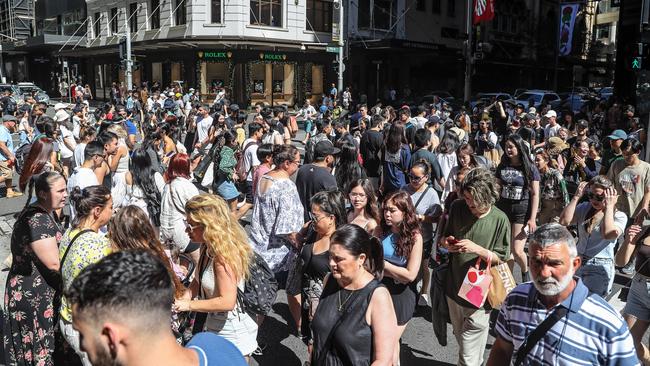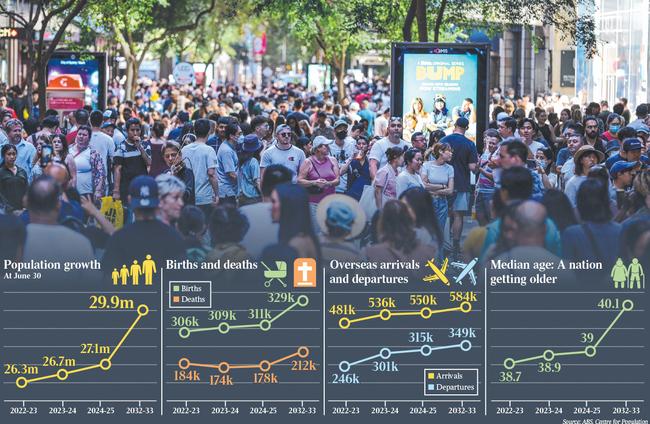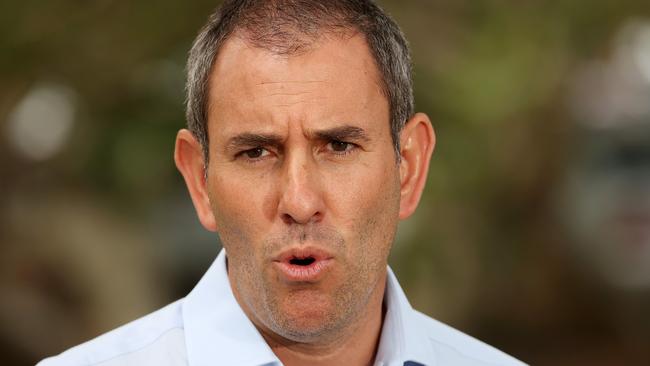Covid leaves country a million short, report says
Australia’s projected population in 2030 will be more than one million people fewer than was forecast prior to the outbreak of Covid-19, a new report has found.

Australia’s projected population in 2030 will be more than one million people fewer than was forecast prior to the outbreak of Covid-19, a new report has found, with lower migration levels and falling fertility rates to blame.
An excerpt from the government’s 2022 Population Statement says the current 26 million population is projected to reach 30 million by 2033 and be just shy of 40 million by 2060.
To be released in full on Friday, the statement notes that Covid-19 and the consequent travel restrictions will result in almost half a million fewer migrants in Australia by 2026 than otherwise would have been the case.
It says that even though those restrictions have lifted, the nation’s future population growth is not expected to return to the 1.6 per cent growth rate experienced for a decade up to 2019.
“Australia’s annual population growth is expected to reach 1.4 per cent in 2022-23, before gradually slowing to 1.2 per cent by 2032-33 (when the total is) expected to reach 29.9 million,” the statement reveals.
“The gradual decline in population growth results from assumptions that net overseas migration remains steady at 235,000 people (a year) over the medium term (so slowly declines as a proportion of the population), and the total fertility rate declines from 1.66 babies per woman in 2021-22 to 1.62 by 2030-31.
“The size of the population is expected to be 1.2 million people (4 per cent) smaller in 2030-31 compared with what was projected in the Mid-Year Economic and Fiscal Outlook 2019-20, prior to the onset of the pandemic.
“Around 30 per cent of this difference is attributable to lower overseas migration. The remainder is the result of a lower fertility assumption and fewer births attributable to migrants,” the Population Statement reads.
The statement also reveals an ageing population, with lower birthrates and more people living longer pushing the median age from 38.4 years in 2021-22 to 40.1 years by 2032-33.
According to the Australian Bureau of Statistics population clock, the nation’s population now sits at 26.24 million.

With population a key driver of economic growth, the federal government faces a demographic dilemma over where to find the nation’s workforce to support the growing number of older Australians, and maintain the overall standard of living.
The government has already increased the cap on permanent migration numbers from 160,000 to 195,000 for this financial year in response to skills shortages exacerbated by the Covid pandemic lockdowns.
It will be under pressure to make that a permanent rise, and maybe increase it as well – an issue that will inevitably be under consideration in the current migration review being led by Home Affairs Minister Claire O’Neil.
Commenting on the outlook, Jim Chalmers said the country had skills and labour shortages, and migration was “a critical” part, but not all of the solution.
“Finding the skilled workers Australian industry needs to grow our economy will be a great challenge in the coming decade but it also provides plenty of opportunities for Australians wanting to work hard and get ahead,” the Treasurer said.

“Our approach recognises that there are no easy solutions to the challenges we face in our economy. We have to pull every lever at our disposal to ensure we get the balance right – and we will.
“Migration will always be important to our economy but it should never be a substitute for training Australians for opportunities or making it easier for parents or seniors to do a bit more work if they want to,” he said.
Dr Chalmers said policy options could make a difference to fertility rates.
“We’re making it cheaper and easier for people to access childcare and early childhood education,” he said.
“That’s a big part of the decision about whether or not people have kids or have more kids.”
Long-term population projections are notoriously difficult, as they are based on assumptions that can quickly change.
The first Intergenerational Report, delivered in 2002 by then treasurer Peter Costello, projected the nation’s 2032 population at 24.5 million – nearly two million people fewer than now and more than five million short of current projections.
That projection was based on net migration inflows of 90,000 people per year.




To join the conversation, please log in. Don't have an account? Register
Join the conversation, you are commenting as Logout